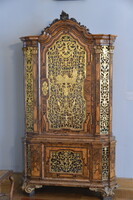| dc.coverage.spatial | Site: Warsaw, Mazowieckie, Poland | en_US |
| dc.coverage.temporal | altered 1598 (alteration); destroyed 1944 (destruction); rebuilt 1971-1988 (other) | en_US |
| dc.creator | Trevano, Giovanni | en_US |
| dc.creator | Castelli, Matteo | en_US |
| dc.date | 1971-1988 | en_US |
| dc.date.accessioned | 2016-07-01T18:40:17Z | |
| dc.date.available | 2016-07-01T18:40:17Z | |
| dc.date.issued | 1971-1988 | en_US |
| dc.identifier | 265532 | en_US |
| dc.identifier.other | archrefid: 3439 | en_US |
| dc.identifier.uri | http://hdl.handle.net/1721.3/181590 | |
| dc.description | Elaborate highboy or secretary with inlaid gilt screen; In 1595, King Sigismund III Vasa made a decision to expand the castle when Warsaw became his new capital. Reconstruction in the Mannerist-early Baroque style was done between 1598-1619. The Castle was enlarged and given its present five-sided shape (pentagon with a courtyard), with an imposing early Roman Baroque style elevation facing the town, and a high (clock) tower known as the Sigismund's Tower. Some north European features include the form of the tower cupolas. It has been reconstructed to this period. Some of the art and interior decoration (including fireplaces, stuccowork, panelling, floors etc.) were saved in 1939 and later replaced. In 1980, the Royal Castle, together with the Old Town was registered as a UNESCO World Heritage Site. Today it is a historical and national monument, and is listed as a national museum. Source: Grove Art Online; http://www.oxfordartonline.com/ (accessed 5/14/2015) | en_US |
| dc.format.medium | red brick; stone | en_US |
| dc.rights | © Scott Gilchrist, Archivision, Inc. | en_US |
| dc.subject | military or war | en_US |
| dc.subject | rulers and leaders | en_US |
| dc.subject | Restoration and conservation | en_US |
| dc.subject | World War, 1939-1945 | en_US |
| dc.subject | Mannerist (Renaissance-Baroque style) | en_US |
| dc.title | Royal Castle, Warsaw | en_US |
| dc.title.alternative | Zamek Królewski w Warszawie | en_US |
| dc.type | image | en_US |
| dc.rights.access | Licensed for educational and research use by the MIT community only | en_US |
| dc.identifier.vendorcode | 1A2-P-W-RCW-A36 | en_US |
| vra.culturalContext | Polish | en_US |
| vra.technique | construction (assembling) | en_US |
| vra.worktype | royal palace | en_US |
| dc.contributor.display | Giovanni Trevano (Italian architect, died ca. 1641-1645); Matteo Castelli (Swiss architect, ca. 1560-1632) and others | en_US |

